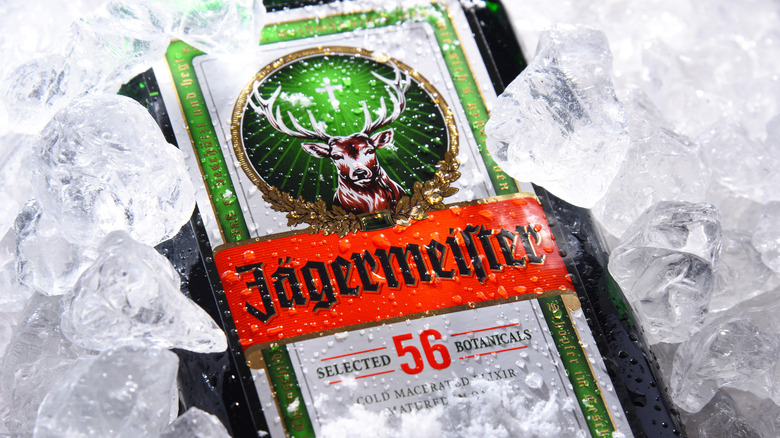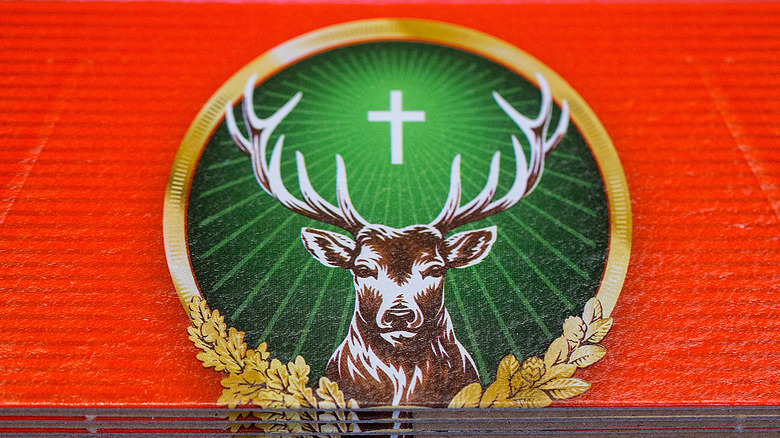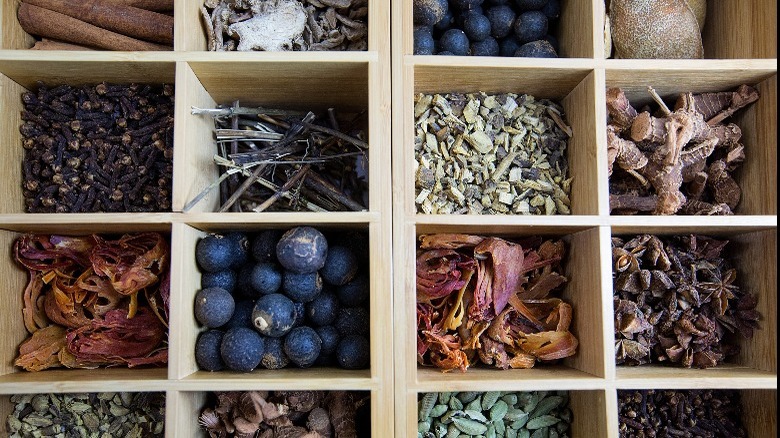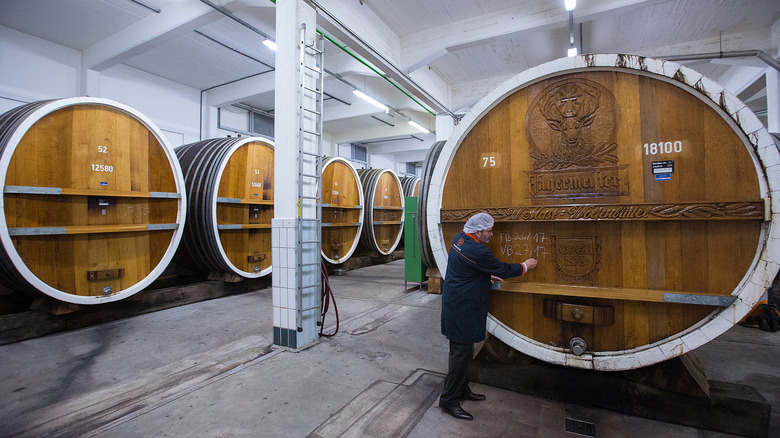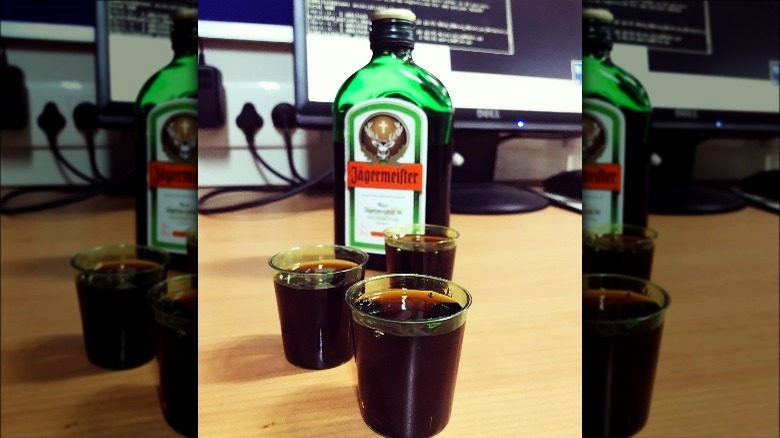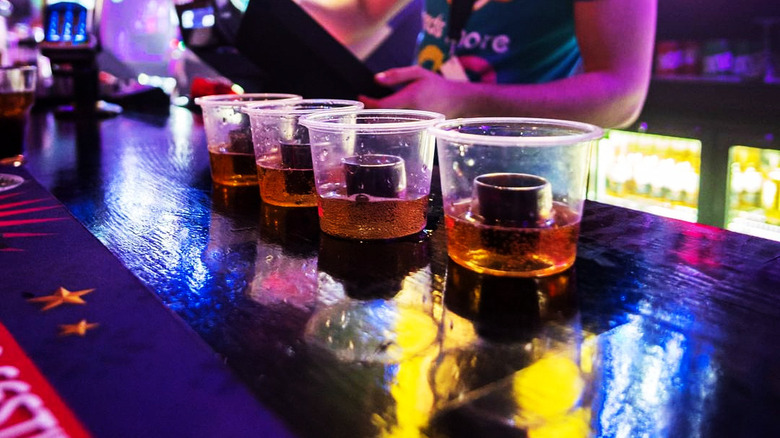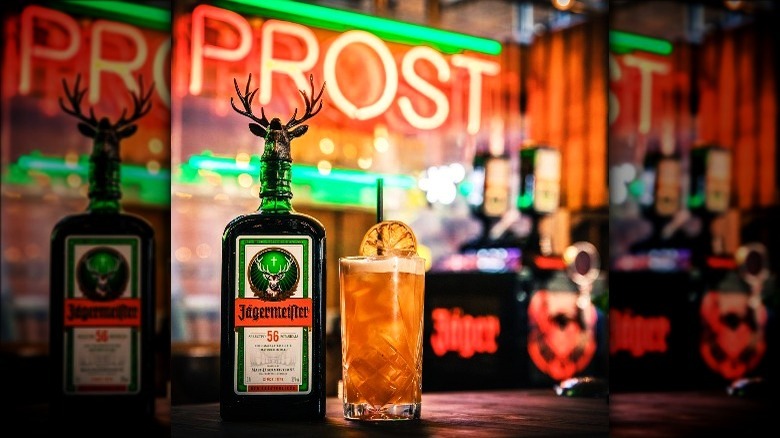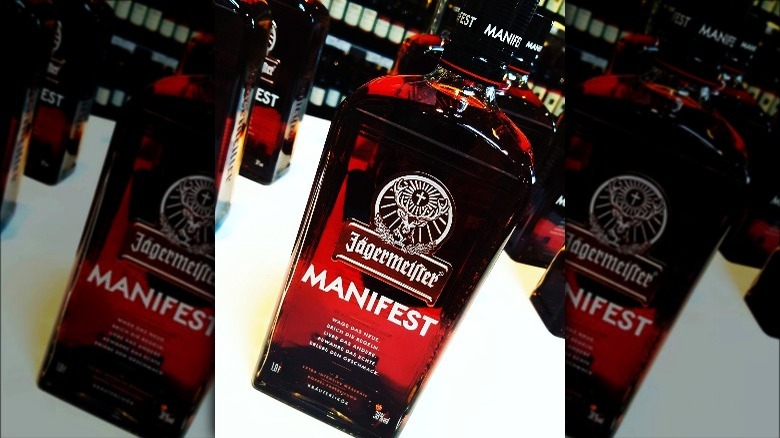What Is Jägermeister And What Is Its Alcohol Content?
We may receive a commission on purchases made from links.
There's no liquor on the market quite like it — at least nothing you're likely to find at your neighborhood bar. For the most part, people who try Jägermeister either love it or hate it. The flavor of this complex liqueur with 56 ingredients is hard to describe, but those who try usually land on the same idea. A 1985 Louisiana newspaper article described Jägermeister as "a mixture of root beer and Vicks Formula 44D cough syrup" (via Men's Journal). A Redditor said it tasted like "black licorice cough syrup," adding "I like it though. Surprisingly easy to drink."
Jägermeister — "Jäger" for short — has gone through quite the evolution, from its creation at the hands of a German vinegar maker's son in 1934 to mainstream American party drink at the end of the 20th century (via A Couple Cooks). How did a syrupy, anise-heavy digestif intended for German hunters get so popular with the drunk and loud U.S. college crowd? What are those 56 herbs and botanicals Jägermeister touts on its label? Keeping in mind Jägermeister's original purpose as an after-dinner digestive aid, and considering all those herbal ingredients, might Jägermeister actually be healthy ... sort of? And what's with the liqueur's name and the Christian elk's head logo?
So many questions. ... Maybe we need to drop another Jäger Bomb and get back on the dance floor.
A Jägermeister history
Necessity is the mother of invention, and creativity may well be the father. Curt Mast had both in spades. As head of a struggling wine and vinegar business in Wolfenbüttel, Germany, Mast needed a new product to improve his company's prospects, according to the Jägermeister website. He created herbal liqueurs as a hobby, and after years of trial and error he concocted a spirit worth marketing. All of that experimentation resulted in a liqueur with 56 "herbs, blossoms, roots, and fruits," according to another Jägermeister webpage. Mast named his invention "Jägermeister," German for "master hunter," to appeal to his people: fellow hunters.
To further enhance the liqueur's mystique in hunting circles, Jägermeister is emblazoned with its famous stag logo: a deer's head with magnificent antlers framing a Christian cross. The image refers to the legend of Hubertus, a once-greedy hunter who turned to religion after encountering a stag with a cross glowing between its horns, according to the Jägermeister history webpage. Hubertus would become the patron saint of hunters, and his life-changing deer would become a German liqueur's unofficial mascot.
In addition to being "a celebratory drink among hunters," Jägermeister traditionally has been consumed as a medicinal. Jäger drinkers claim the stuff fixes a cough or sore throat (via Thrillist), or soothes an upset stomach, per The Manual.
What is in Jägermeister, exactly?
Jägermeister's 56 ingredients are a closely guarded secret at company headquarters. An enterprising reporter for The Washington Post named Jason Wilson attempted to crack the code. He whipped out his notebook during a tour of the factory, where he found a full list of the herbs and botanicals. A Jägermeister rep tried to distract him with a list of five publicly acknowledged ingredients: cloves, ginger root, camomile flowers, cinnamon bark, and saffron. But Wilson made off with at least some of the complete list. "There may or may not be licorice root, lavender, and rose hips, as well as many of the herbs and spices usually found in bitters," he wrote. The Manual uncovered more ingredients: star anise, poppy seeds, ginseng, and juniper. WebMD's list adds bitter orange, and Men's Journal mentions cardamom.
Two things we can confidently say are not in Jägermeister have been the subject of persistent rumors and myths. While Jägermeister was initially drunk as a medicinal and marketed to hunters, no opiates contribute to the liqueur's medical value, and the lure for hunters does not extend to the addition of elk's blood, as The Washington Post made clear. In fact, VinePair notes that Jägermeister is vegan. You don't have to mention that to the hunters, though.
How is Jägermeister made?
As you might imagine, with those dozens of herbs and botanicals and that one-of-a-kind flavor, making Jägermeister is complex. The recipe is the same as it was in 1934, according to the Jägermeister website. Each of the 56 dry ingredients must be weighed to exact specifications. The ingredients macerate, or steep, in separate batches in a 70% alcohol solution. Herbs that take longer to give up their essential oils are steeped longer in their own batches, while other batches steep more quickly. (You get the idea that even if you knew all 56 ingredients, you could never come close to making a Jägermeister clone.) The Washington Post reporter who took the tour noted the alcohol is "pure, neutral spirits," so it won't bring any of its own flavor to the table.
The different batches of steeped ingredients are combined, filtered, and then stored in oak barrels for one year. The oak is "de-flavorized" with an alcohol wash before the barrels are filled. Jägermeister isn't whiskey; the distillers don't want any oak flavor seeping into their product.
What comes out of the barrels is filtered a second time; then combined with a mixture of alcohol, water, caramel, and sugar; then filtered again to produce the Jägermeister on your liquor store or barroom shelf.
Nutritional information about Jägermeister
With all the plant material that goes into Jägermeister, you might think the liqueur has some vitamins and minerals. This would be wishful thinking. The organics are thoroughly filtered out, leaving a beverage consisting of alcohol, water, sugar, and essential oils, according to WebMD. Cloves and anise contain beneficial compounds that can reduce inflammation, so there's that.
In terms of basic nutrition facts, a 1.5 ounce Jäger shot has no nutritional value to speak of. It's notable only for its 19 grams of sugar and 167 calories. Given those numbers, it's worth emphasizing that Jägermeister has four times the sugar by volume than Coke, based on nutrition facts from the Coca-Cola website, and a single shot has more calories than a whole can of the soft drink.
Jägermeister is 35% alcohol by volume (via A Couple Cooks), making it a little weaker than run-of-the-mill distilled spirits that are 80 proof (40% ABV): rum, whiskey, vodka, and such. Jägermeister isn't in that category; it's a liqueur, which the Bols Bartending Academy website describes as alcohol with added sugar and infused with fruits, nuts, herbs, or cream. Jägermeister is on the strong end of the scale among liqueurs, according to Alcohol Content Database. Baileys Irish Cream is 17% ABV, and Amaretto is 28%. Italian anise-flavored liqueur Sambuca and orangey Cointreau are a little stronger, at 40%.
With all that sugar and alcohol, Jägermeister brings certain long-term health risks, per WebMD: obesity, liver disease, addiction, and a shorter lifespan.
How did Jägermeister become the party drink of choice?
Somehow, Jägermeister went from an after-dinner digestif for older Germans to the party elixir for 20-something Americans in the 1990s. Credit goes to enterprising importer Sidney Frank, who saw potential in Jägermeister's uniqueness and had secured import rights to the beverage nationwide in 1973, according to Inc. magazine. With no advertising budget, Frank got a 1985 article from the Baton Rouge newspaper to go viral before virality (or the internet, anyway) was a thing. According to Men's Journal, he made copies of the article, which called Jägermeister "liquid Valium," and handed them out at New Orleans bars, boosting the drink's intrigue and its sales. Then Frank adopted the unoriginal marketing concept "sex sells" by deploying women dubbed Jägerettes to bars. They would shoot Jägermeister directly into willing patrons' mouths. In a mild nod to inclusivity, Frank eventually recruited a much smaller legion of Jägerdudes, too.
Frank's last major contribution landed on bar surfaces in the early 1990s, according to The Spirits Business: a highly visible Jägermeister cooler than dispensed shots from a tap at the ideal temperature of zero degrees Fahrenheit. Even Frank himself admitted, "warm Jägermeister is terrible."
Jägermeister was a staple in the college party scene by the 1990s, according to Thrillist, and its position only became more entrenched after somebody came up with the Jäger Bomb: a shot of the liqueur dropped in a glass of Red Bull.
How to drink Jägermeister
The freezer-cold shot and the highly caffeinated Jäger Bomb may have propelled Jägermeister to party infamy, but there are other, less publicized ways to take your German herbal medicine. The Washington Post reporter who visited Jägermeister's hometown of Wolfenbüttel discovered the Jägermeister and tonic there, served with a slice of orange. "I ... would wholeheartedly recommend that drink," he said.
The Jägermeister website offers several cocktail recipes, among them the Jägermeister Cut (a split shot of Jäger and bourbon), Hunter's Tea (black tea, Jäger, lime juice, and maple syrup on ice), and the Jägermeister Mule (lime, Jäger, and ginger beer on the rocks).
Liquor.com said in 2020 that Jägermeister had made inroads into the craft cocktail scene with concoctions such as the Surfer on Acid (Jäger, coconut rum, pineapple juice) and the Precision Timepiece (Jäger, Aperol, Amaro Montenegro, bitters). Maybe that's a little too much precision for a party crowd that likes any drink with "bomb" in the name.
Jägermeister varieties and some alternatives
Jägermeister's lone product thrived a long time in its unique niche. But the Wolfenbüttel distillers didn't want to rest on their laurels and the 56 other herbs and botanicals. In 2017, Jägermeister unveiled a super-premium herbal liqueur, Jägermeister Manifest, for the "more discerning drinker" (via The Spirits Business). It's barrel-aged twice and comes with some extra botanicals, resulting in what must be a smoother taste. The recommended temperature for shooting (in this case, maybe even sipping) isn't zero degrees. It's more like 45 degrees.
Wolfenbüttel headquarters launched Jägermeister Scharf in 2019, with added heat from ginger and galangal, according to another Spirits Business article. Jägermeister Cold Brew entered the U.S. market in January 2020: the original liqueur blended with coffee and cacao. A Jäger rep told Food & Wine it was following the lead of its customers, who already mixed Jägermeister and coffee.
Jägermeister lovers can try some close cousins among its competition. Fernet-Branca, available on Target's website, is more bitter with menthol and anise flavors, per Thrillist. Intensely bitter Gammel Dansk was created to compete against Jägermeister and Fernet-Branca. Gammel Dansk is the second most popular spirit in its native Denmark, although your best bet for finding it in the U.S. might be online, at sites such as The Whisky Exchange. If you thought Jägermeister had a unique niche, check this out: Regular Gammel Dansk drinkers apparently enjoy it with breakfast. Too bad for the distillers in Wolfenbüttel — the Jägerettes and 'dudes are probably still asleep.
